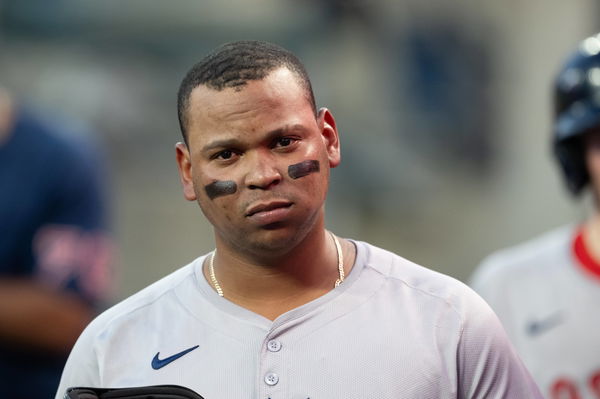
via Imago
MLB, Baseball Herren, USA Boston Red Sox at Detroit Tigers Boston Red Sox third base Rafael Devers 11 during a game between the Detroit Tigers and the Boston Red Sox on Friday, August 30, 2024 in Detroit . Carl Jones II/Image of Sipa USA Detroit MI USA NOxUSExINxGERMANY PUBLICATIONxINxALGxARGxAUTxBRNxBRAxCANxCHIxCHNxCOLxECUxEGYxGRExINDxIRIxIRQxISRxJORxKUWxLIBxLBAxMLTxMEXxMARxOMAxPERxQATxKSAxSUIxSYRxTUNxTURxUAExUKxVENxYEMxONLY Copyright: xImagexofxSportx Editorial use only

via Imago
MLB, Baseball Herren, USA Boston Red Sox at Detroit Tigers Boston Red Sox third base Rafael Devers 11 during a game between the Detroit Tigers and the Boston Red Sox on Friday, August 30, 2024 in Detroit . Carl Jones II/Image of Sipa USA Detroit MI USA NOxUSExINxGERMANY PUBLICATIONxINxALGxARGxAUTxBRNxBRAxCANxCHIxCHNxCOLxECUxEGYxGRExINDxIRIxIRQxISRxJORxKUWxLIBxLBAxMLTxMEXxMARxOMAxPERxQATxKSAxSUIxSYRxTUNxTURxUAExUKxVENxYEMxONLY Copyright: xImagexofxSportx Editorial use only
It’s not easy letting go of the glove, especially when it’s been part of your baseball identity for a decade. Rafael Devers knows that. The Boston Red Sox slugger spent years manning third base, making the occasional highlight-reel play, living with the errors, and leaning on his bat to smooth things over. But now, the Red Sox are asking him to be something else entirely: a designated hitter. And that’s not going well. In times like these, advice from a Hall of Famer can do wonders—if Devers has the ears for it.
Through the first month of the season, Devers looks like a man caught in transition. The rhythm isn’t there, and neither is the confidence. He’s pacing between at-bats, looking stiff, and more often than not, swinging like he’s trying to solve a puzzle mid-pitch. It’s unfamiliar territory, and it shows.
That’s why Edgar Martinez, who has already walked that path and now serves as Seattle’s senior director of hitting strategy, offered much-needed piece of advice that cut through the noise like a line drive: “For someone trying to hit, thinking too much is not a good thing.”
ADVERTISEMENT
Article continues below this ad

It sounds simple, but Devers isn’t there yet. His first month as full-time DH has been a grind, riddled with poor timing, visible frustration, and far too many quiet nights at Fenway. The spotlight hasn’t dimmed. If anything, it’s more blinding—because now, his glove can’t save him. His legs won’t earn him goodwill. It’s all about the bat, and so far, it’s not talking. Martinez knows that pressure. “What if I don’t hit for a month? What if I lose my rhythm?” he remembered thinking. That doubt can eat you alive.
But that can’t be an excuse. There’s a routine to build, a mindset to master. Martinez found his groove by sticking to a strict between-at-bats program: tee work, bike rides, and constant mental reps. He stayed loose, engaged, and ready. And Devers? He’ll need to figure out what keeps him locked in during those long, lonely innings between at-bats.
There’s also the evolving nature of the DH role. Martinez was once the prototype: bat-only, fearsome, immovable. Today, teams rotate players through the spot like it’s a rest day slot. That makes Devers’ situation even more unique. Boston isn’t resting him. They’re betting on him to carry the offense—every single night. The numbers so far don’t justify the faith. But as Martinez showed, the transition is less about mechanics and more about mindset. And for Devers, embracing the change isn’t optional. It’s the only way forward.
What’s your perspective on:
Can Rafael Devers overcome his DH struggles, or is Boston's $280 million bet a bust?
Have an interesting take?
Because in a season that’s already teetering, Boston needs their $280 million bat to finally show up.
ADVERTISEMENT
Article continues below this ad
Rafael Devers caught between power and precision
Here’s the strange part—Devers is actually crushing the baseball when he makes contact. His current hard-hit rate is a career-best 60.9%. That’s elite territory. So, it’s not like the power has vanished. But the issue? He’s just not hitting the ball enough. Only three players in the entire league are swinging and missing more than Devers’ jaw-dropping 38.7% whiff rate. That number isn’t just high, it’s unprecedented for him. The only time he even came close was during the pandemic-shortened 2020 season, and even then, it was over seven points lower.

via Imago
Boston Red Sox’s Rafael Devers heads to the dugout after striking out during the ninth inning of a baseball game against the Texas Rangers, Saturday, March 29, 2025, in Arlington, Texas. (AP Photo/LM Otero)
Even more alarming? He’s whiffed at 44 pitches in the heart of the strike zone, according to Baseball Savant. That’s not just a red flag, it’s a blaring siren. The next closest hitter, Minnesota’s Matt Wallner, has 25. “Dominating in the strike zone but swinging and missing in the strike zone, and that’s something we have to work on, mechanics-wise,” Alex Cora admitted after another frustrating loss.
ADVERTISEMENT
Article continues below this ad
The Red Sox can cover some of Devers’ struggles with more lineup depth now, sure, but if they’re serious about contending, the real Devers, the dependable middle-of-the-order threat, needs to show up and stick around.
ADVERTISEMENT
ADVERTISEMENT
ADVERTISEMENT
ADVERTISEMENT


"Can Rafael Devers overcome his DH struggles, or is Boston's $280 million bet a bust?"